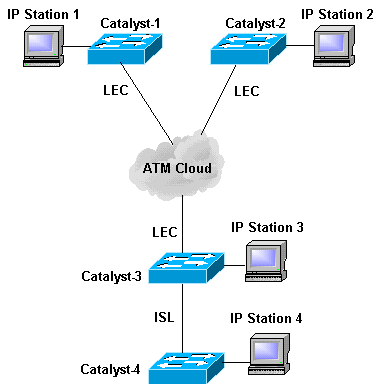Problems With VLAN Trunk Protocol (VTP) Pruning Over LAN Emulation (LANE)
Available Languages
Contents
Introduction
Note: The information in this document is based on the Catalyst 5000 Family of switches and Switch Software Release 4.4(5). The feature first appeared in release 2.3.
This document explains why you should never use VLAN Trunking Protocol (VTP) pruning on Catalyst series switches attached to Emulated Local Area Networks (ELANs). VTP pruning increases available bandwidth by restricting flooded traffic to those trunk links that the traffic must use to access the appropriate network devices. With VTP, Catalyst series switches exchange messages using Layer 2 frames sent to a Cisco Multicast Media Access Controller (MAC) address.

Note: The locations of the LAN Emulation Server (LES), the broadcast and unknown server (BUS), and the LAN Emulation Configuration Server (LECS) are unimportant for these examples.
Prerequisites
Requirements
There are no specific requirements for this document.
Components Used
This document is not restricted to specific software and hardware versions.
Conventions
Refer to Cisco Technical Tips Conventions for more information on document conventions.
Example 1: Three IP Stations
In this example, there are three IP stations in virtual LAN (VLAN) #500 (500 is an arbitrary number). The first station is connected to Catalyst-1, the second to Catalyst-2, and the third to Catalyst-3. Any station pings any other without a problem, and no other VLAN #500 stations exist in this network. If you ping nonstop from the station on Catalyst-1 to the station on Catalyst-2, this works fine. If you remove the station on Catalyst-3, there are no other stations in VLAN #500 connected to Catalyst-3. If pruning is configured, the Catalyst-3 advertises the lack of stations by broadcasting a multicast message. In LAN emulation (LANE), this message is sent by the BUS and received by all of the LAN Emulation Clients (LECs). Catalyst-1 and Catalyst-2 receive this message and believe that there are no more stations in VLAN #500 in the ELAN. As a result, all of the LECs stop forwarding any traffic on this VLAN. Thus, if you unplug the station on Catalyst-3, you stop communication between stations on Catalyst-2 and Catalyst-1.
Example 2: Four IP Stations
Now, assume there are four IP stations, with the last one connected to Catalyst-4. If you unplug the station on Catalyst-4, a multicast message is broadcast over the ISL trunk and hits only the Catalyst-3. This stops traffic from forwarding to Catalyst-4 for this VLAN, as expected.
Pruning is good for point-to-point links like Inter-Switch Link (ISL). With an ELAN-based network, pruning can be enabled on the server but VLANs should not be pruning-eligible on a Catalyst connected to LANE. You can make specific VLANs pruning ineligible with the clear vtp pruneeligible vlan_range command. By default, VLANs 2-1000 are pruning-eligible.
Related Information
Revision History
| Revision | Publish Date | Comments |
|---|---|---|
1.0 |
01-Jan-2007 |
Initial Release |
Contact Cisco
- Open a Support Case

- (Requires a Cisco Service Contract)
 Feedback
Feedback